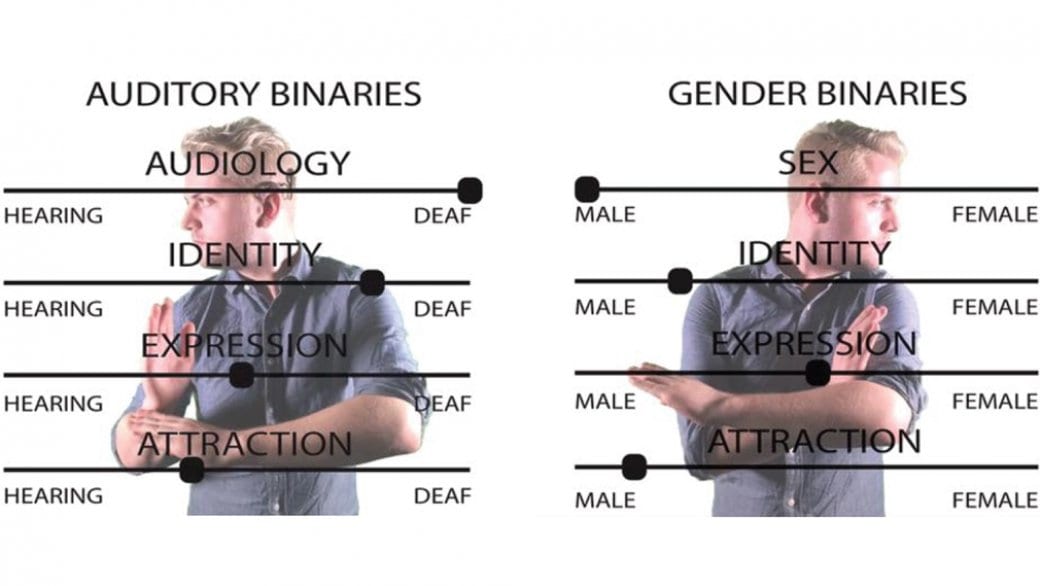“I always say there’s more hearing people than white people, more hearing people than males — more hearing people than any other majority group in the world,” Landon Krentz says.
Krentz is a deaf-queer artist living in Vancouver.
His latest self-portrait aims to bring awareness to the challenges of being deaf in a hearing world, and to compare the experience to being queer in a predominantly straight world.
It also challenges the idea that hearing exists on a strict binary of absolutes. It’s more of a fluid spectrum, he says, like gender and sexuality.
(Artist Landon Krentz explains his new self-portrait in American Sign Language./Hannah Ackeral video)
Krentz sees many similarities between deaf and queer culture.
“I think the queer and deaf community are very similar because they have experiences that don’t follow the social norms,” he says. “For example, most deaf children have hearing parents, most queer children have straight parents, so how are they learning about their identities?”
“Identity is something I was not born with,” he says. “It was something I had to find.”

(“I was starting to question: why do I feel invisible? Is it because I don’t ‘look” deaf? Because I navigate in the hearing world very well?” asks Krentz, who considers the role of his cochlear implant in this earlier self-portrait. “I think I’m flying on the assumption that I am a fully functional human being, but I have challenges and I’ve faced lots of barriers and people don’t acknowledge that because it’s not visible.”)
Krentz began to fully embrace his identity as a deaf person when he moved to Vancouver four years ago at the age of 21. Once here, he improved his signing fluency and connected with members of the deaf community.
Like most people Krentz says he’s met in the deaf community, his deaf identity is dominant — he sees himself as deaf before queer. He says it can be more of a challenge to be deaf in the queer community, than queer in the hearing community.
“I’ve never met one person in the deaf community who identifies as queer first and deaf second,” he says.
“Of course, I have friends who identify as deaf queer people of colour, DQPOC, and they don’t even talk about their POC status,” he continues. “When you have one identity, it’s already complicated enough. You’re growing, changing, evolving, you’re always thinking about it. But when you add another identity it’s more work to try and understand and accommodate both. When you have three, I wouldn’t even have a clue. I have so much respect for those people who are confident, empowered, and have that sense of awareness. It really challenges me. One identity is hard enough.”
(“If you’re new to the deaf and/or queer community, please don’t feel alone in this world,” Krentz says./Hannah Ackeral video)
As someone with a cochlear implant (a surgically implanted microphone that amplifies sound and allows Krentz to hear environmental noises), who is bilingual in both English and American Sign Language, Krentz says he’s in a unique position to access both the hearing and deaf communities. He describes himself more as an activist than an artist.
“I think it’s really important that I raise visibility for the deaf community because we’re not being acknowledged,” he says. “There’s so many other identities that we acknowledge in Canada.”
“I want to challenge social norms and use my project as a vehicle to change different ideas and perspectives,” he says.
Landon Krentz is an artist and a deaf-queer activist who is bilingual in American Sign Language and English (though, he says, readers may notice some language delay or translation errors). Check out his Facebook page to find out more about his work, and follow him on Instagram.

 Why you can trust Xtra
Why you can trust Xtra


